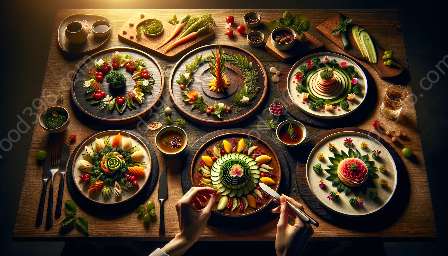Fruit carving is a unique and beautiful art form that has been practiced for centuries in various cultures around the world. It involves creating intricate and decorative designs on fruits, transforming them into stunning displays that not only look amazing but also enhance the overall dining experience. Fruit carving is perfectly compatible with food garnishing and preparation techniques, as it adds an element of creativity and artistry to the presentation of dishes, making them more visually appealing and appetizing.
The History of Fruit Carving
The origins of fruit carving can be traced back to ancient civilizations such as China, Thailand, and Japan, where it was initially used as a way to showcase the wealth and status of the ruling class. Over time, fruit carving evolved into a popular art form practiced by skilled artisans and chefs, with its techniques and styles varying across different regions.
Tools and Techniques
Carving fruits requires precision, patience, and the right tools. Common tools used for fruit carving include specialized knives, melon ballers, and intricate carving tools. Each fruit has its own texture, density, and moisture content, making it essential to understand the appropriate techniques and tools for different types of fruits. Some popular techniques in fruit carving include relief carving, etching, and shaping, each of which requires specific skills and attention to detail.
Fruit Selection and Preparation
When it comes to fruit carving, the selection and preparation of fruits play a crucial role. Fruits with firm flesh, such as watermelons, cantaloupes, pineapples, and papayas, are commonly used for carving due to their ability to hold intricate designs and shapes. Before carving, fruits need to be carefully washed, peeled, and sometimes hollowed out to create a clean canvas for carving. Moreover, understanding the natural colors and textures of different fruits is essential for creating visually appealing carvings.
Food Garnishing Techniques
Food garnishing techniques involve enhancing the visual appeal of dishes by adding decorative elements, such as carved fruits and vegetables, herbs, edible flowers, and sauces. Fruit carving perfectly complements food garnishing techniques by providing unique and eye-catching garnishes that elevate the presentation of various dishes. Whether it's a simple fruit platter or an elaborate buffet spread, expertly carved fruits can add artistic flair and sophistication to any culinary creation.
Compatibility with Food Preparation Techniques
While fruit carving focuses on the visual aspect of food presentation, it seamlessly integrates with food preparation techniques. Whether it's the preparation of fruit salads, fruit tarts, or fruit kebabs, the incorporation of intricately carved fruits can elevate the overall aesthetic and appeal of the dish. Additionally, carved fruits can be used to garnish beverages, desserts, and main courses, showcasing the seamless compatibility of fruit carving with various food preparation methods.
Modern Applications
Today, fruit carving has found its way into modern culinary settings, including restaurants, hotels, and catering services, where it is used to create visually stunning centerpieces, buffet displays, and decorative platters. In addition, social media platforms and cooking shows have popularized fruit carving as a form of edible art, inspiring individuals to explore their creativity and imagination in presenting fruits in unique and captivating ways.
Learning Fruit Carving
Mastering the art of fruit carving requires dedication, practice, and a deep understanding of fruits and their properties. There are numerous classes, workshops, and online tutorials available for individuals interested in learning fruit carving techniques. Aspiring fruit carvers can explore the intricate world of fruit carving through step-by-step guidance and hands-on practice, allowing them to develop their skills and create stunning fruit designs.
Conclusion
Fruit carving is a fascinating art form that not only showcases the beauty of nature but also adds an element of creativity and sophistication to the culinary world. Its compatibility with food garnishing and preparation techniques makes it a valuable skill for chefs, culinary enthusiasts, and anyone passionate about creating visually stunning and delectable food displays. By incorporating fruit carving into culinary endeavors, individuals can transform ordinary fruits into extraordinary works of art that delight the senses and elevate the dining experience.

